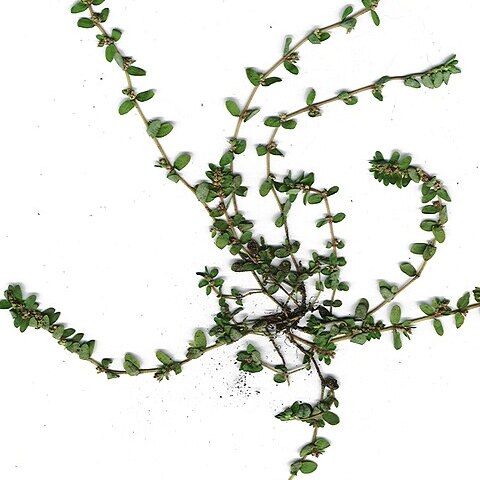Prostrate densely branching annual herb, with branches to 25 cm. long, glabrous on the undersurface, the upper surface densely pilose with fairly long curved adpressed hairs, the whole plant tinged reddish brown.. Leaves ovate, to 8 × 4 mm., base obliquely subcordate, apex obtuse, margin shallowly toothed, upper surface glabrous, the lower surface with long scattered hairs; petiole 0.5 mm. long; stipules free, linear, to 1.25 mm. long, often deeply 2–3-toothed, pilose.. Cyathia solitary, subsessile, terminal and pseudoaxillary on congested leafy shoots, ± 0.5 × 0.5 mm., with funnel-shaped involucres, pilose; glands 4, minute, subcircular, red, with often almost invisible red appendages; lobes minute, triangular, ciliate.. Male flowers very few (5 or less): bracteoles reduced to 1 or 2 threads; stamens 0.8 mm. long.. Female flower: ovary subsessile; styles 0.6 mm. long, erect, bifid to halfway.. Capsule subsessile (pedicel 0.2 mm. long), splitting the involucre during development, 3-lobed, with truncate base, 1 × 1 mm., pilose with short adpressed hairs.. Seeds conical, sharply 4-angled, 0.6 × 0.4 mm., reddish brown, with shallow transverse ridges and grooves.
Herbs, annual, 10-20 cm tall. Root fibrous. Stems slender and thin, many from base, usually prostrate, 1-2(-3) mm thick, with many adventitious roots, sparsely pilose. Leaves opposite; stipules lanceolate or linear, 1-1.5 mm, easily fallen; petiole ca. 1 mm; leaf blade rounded or cordate, margin usually finely serrulate, occasionally entire, both surfaces pubescent. Cyathia single or numerous clustered and axillary, peduncle 1-2 mm, sparsely pilose; involucre campanulate to turbinate, ca. 1 × 1 mm, outside shortly pilose, marginal lobes 5, ovate; glands 4, appendage white. Male flowers few, slightly exserted from involucre. Female flower: pedicel short; ovary shortly pubescent; styles free; stigma 2-lobed. Capsule 3-angular-ovoid, ca. 1.5 × 1.3-1.5 mm, smooth, shortly pubescent. Seeds ovoid-tetragonal, ca. 0.7 × 0.5 mm, dark red, each side with 4 or 5 transverse furrows; caruncle absent. Fl. and fr. Jun-Nov.
Leaves with a petiole 0.5 mm long; stipules to 1.25 mm long, linear, often deeply 2–3-toothed, pilose; lamina to 8 × 4 mm, ovate, obtuse at the apex, obliquely subcordate at the base, shallowly toothed at the margin, upper surface glabrous, lower surface with long scattered hairs.
Cyathia terminal and pseudoaxillary on congested leafy shoots, solitary, subsessile, c. 0.5 × 0.5 mm, with funnel-shaped involucres, pilose; glands 4, minute, subcircular, red, with often almost invisible red appendages; lobes minute, triangular, ciliate.
An annual spreading and much branched slender herb up to 20 cm long. The stems are usually reddish. The leaves are opposite and 4 to 7 mm long. The flowers are small and not easily noticed crowded on short branchlets in the axils of the leaves.
Prostrate densely branching annual herb, whole plant tinged reddish-brown; branches to 25 cm long, glabrous on the underside, densely pilose above with curved appressed hairs.
Capsule subsessile, splitting the involucre during development, 1 × 1 mm, 3-lobed with a truncate base, pilose with short appressed hairs.
Seeds 0.6 × 4 mm, conical, sharply 4-angled, with shallow transverse ridges and grooves, reddish-brown.
Male flowers very few (5 or less): bracteoles reduced to 1 or 2 threads; stamens 0.8 mm long.
Female flower: ovary subsessile; styles 0.6 mm long, erect, bifid to halfway.
Involucral glands red
Leaves often purplish
An introduced weed.
A prostrate herb

